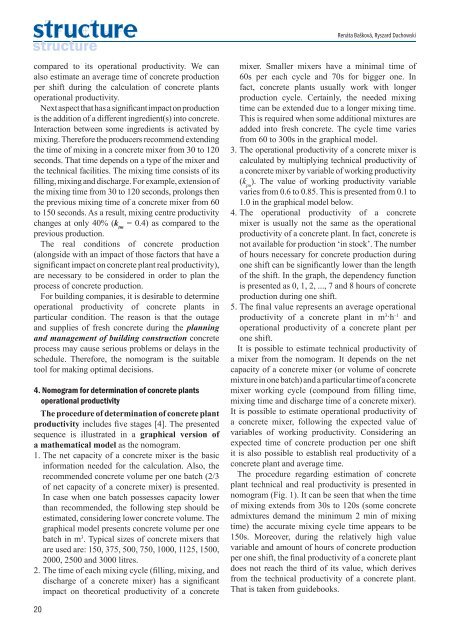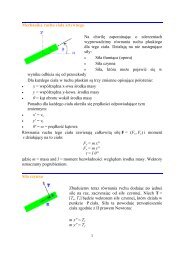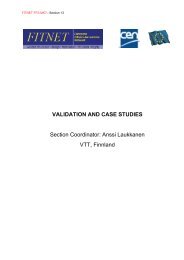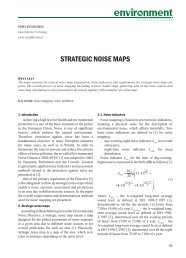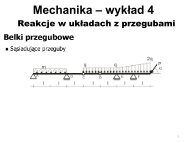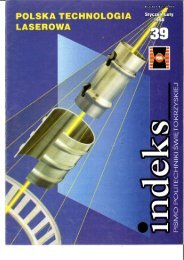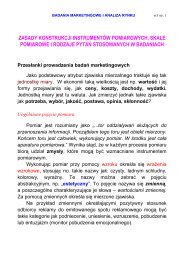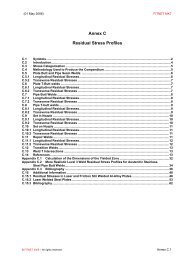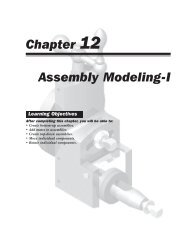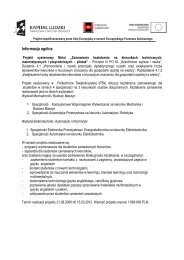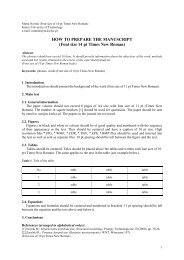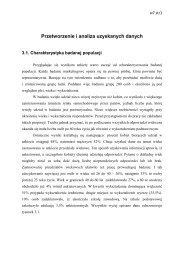Pobierz pełny numer 1/2010 S&E - Structure and Environment - Kielce
Pobierz pełny numer 1/2010 S&E - Structure and Environment - Kielce
Pobierz pełny numer 1/2010 S&E - Structure and Environment - Kielce
- No tags were found...
You also want an ePaper? Increase the reach of your titles
YUMPU automatically turns print PDFs into web optimized ePapers that Google loves.
Renáta Bašková, Ryszard Dachowskicompared to its operational productivity. We canalso estimate an average time of concrete productionper shift during the calculation of concrete plantsoperational productivity.Next aspect that has a significant impact on productionis the addition of a different ingredient(s) into concrete.Interaction between some ingredients is activated bymixing. Therefore the producers recommend extendingthe time of mixing in a concrete mixer from 30 to 120seconds. That time depends on a type of the mixer <strong>and</strong>the technical facilities. The mixing time consists of itsfilling, mixing <strong>and</strong> discharge. For example, extension ofthe mixing time from 30 to 120 seconds, prolongs thenthe previous mixing time of a concrete mixer from 60to 150 seconds. As a result, mixing centre productivitychanges at only 40% (k tm= 0.4) as compared to theprevious production.The real conditions of concrete production(alongside with an impact of those factors that have asignificant impact on concrete plant real productivity),are necessary to be considered in order to plan theprocess of concrete production.For building companies, it is desirable to determineoperational productivity of concrete plants inparticular condition. The reason is that the outage<strong>and</strong> supplies of fresh concrete during the planning<strong>and</strong> management of building construction concreteprocess may cause serious problems or delays in theschedule. Therefore, the nomogram is the suitabletool for making optimal decisions.4. Nomogram for determination of concrete plantsoperational productivityThe procedure of determination of concrete plantproductivity includes five stages [4]. The presentedsequence is illustrated in a graphical version ofa mathematical model as the nomogram.1. The net capacity of a concrete mixer is the basicinformation needed for the calculation. Also, therecommended concrete volume per one batch (2/3of net capacity of a concrete mixer) is presented.In case when one batch possesses capacity lowerthan recommended, the following step should beestimated, considering lower concrete volume. Thegraphical model presents concrete volume per onebatch in m 3 . Typical sizes of concrete mixers thatare used are: 150, 375, 500, 750, 1000, 1125, 1500,2000, 2500 <strong>and</strong> 3000 litres.2. The time of each mixing cycle (filling, mixing, <strong>and</strong>discharge of a concrete mixer) has a significantimpact on theoretical productivity of a concretemixer. Smaller mixers have a minimal time of60s per each cycle <strong>and</strong> 70s for bigger one. Infact, concrete plants usually work with longerproduction cycle. Certainly, the needed mixingtime can be extended due to a longer mixing time.This is required when some additional mixtures areadded into fresh concrete. The cycle time variesfrom 60 to 300s in the graphical model.3. The operational productivity of a concrete mixer iscalculated by multiplying technical productivity ofa concrete mixer by variable of working productivity(k pu). The value of working productivity variablevaries from 0.6 to 0.85. This is presented from 0.1 to1.0 in the graphical model below.4. The operational productivity of a concretemixer is usually not the same as the operationalproductivity of a concrete plant. In fact, concrete isnot available for production ‘in stock’. The numberof hours necessary for concrete production duringone shift can be significantly lower than the lengthof the shift. In the graph, the dependency functionis presented as 0, 1, 2, ..., 7 <strong>and</strong> 8 hours of concreteproduction during one shift.5. The final value represents an average operationalproductivity of a concrete plant in m 3. h -1 <strong>and</strong>operational productivity of a concrete plant perone shift.It is possible to estimate technical productivity ofa mixer from the nomogram. It depends on the netcapacity of a concrete mixer (or volume of concretemixture in one batch) <strong>and</strong> a particular time of a concretemixer working cycle (compound from filling time,mixing time <strong>and</strong> discharge time of a concrete mixer).It is possible to estimate operational productivity ofa concrete mixer, following the expected value ofvariables of working productivity. Considering anexpected time of concrete production per one shiftit is also possible to establish real productivity of aconcrete plant <strong>and</strong> average time.The procedure regarding estimation of concreteplant technical <strong>and</strong> real productivity is presented innomogram (Fig. 1). It can be seen that when the timeof mixing extends from 30s to 120s (some concreteadmixtures dem<strong>and</strong> the minimum 2 min of mixingtime) the accurate mixing cycle time appears to be150s. Moreover, during the relatively high valuevariable <strong>and</strong> amount of hours of concrete productionper one shift, the final productivity of a concrete plantdoes not reach the third of its value, which derivesfrom the technical productivity of a concrete plant.That is taken from guidebooks.20


